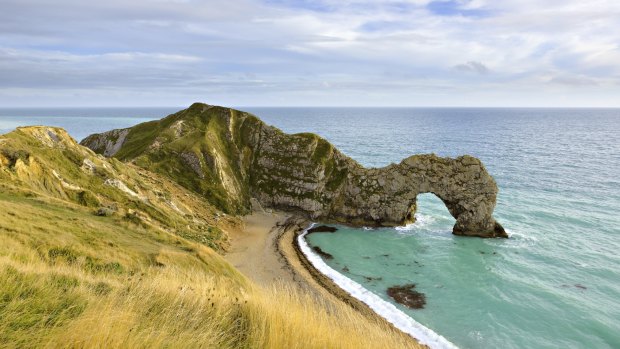This was published 7 years ago
Tyneham, Dorset: Ghost villages and castles on the Jurassic Coast
By Keith Austin

Durdle Door in Dorset on the south coast of England. This part of England is known as the Jurassic Coast.Credit: iStock
Six days before Christmas 1943, Winston Churchill, the British prime minister, ordered the denizens of Tyneham in Dorset to vacate their village so troops could practise for the D-Day landings. They could, he promised, have it back after the war.
Unfortunately, it seems Churchill's promise was made with those famous V-sign fingers crossed behind his back and Tyneham today is still empty and still used by the Ministry of Defence for military manoeuvres.
As isolated World War II ghost villages go, Tyneham has it all – a cold, dirty-white mist that clings to the surrounding hillsides and hangs between suitably gnarled trees like ectoplasm, and an irritating lack of signs pointing the way. "They should rename this bloody place Brigadoon," I find myself saying after yet another wrong turn.
Then the fog, as in all good ghost stories, magically parts to reveal a grey stone village complete with church (St Mary's), an old-fashioned phone box by a pond and rows of derelict buildings and sporadic, unroofed cottages.
Open to the public when it's not swarming with soldiers, this time-warp village is an eerie peek into the past. The church and the schoolroom have been kept intact and serve as permanent reminders of life in the village before WWII intervened. The old schoolroom is especially poignant, preserved as if the children have just nipped out for lunch, their exercise books still set out on old wooden desks (Arthur Grant's story about a nature walk got a "Well done" and a polite order to write out his misspellings 10 times).
Tyneham sits on the flatlands just above Worbarrow Bay, one of the gaps in the plunging cliffs that guard this part of the coast against the ravages of the English Channel. Just to the west are the much-photographed natural rock arch of Durdle Door and the pretty circular bay and village of Lulworth Cove.
This is just a small part of Dorset's famed 155-kilometre-long Jurassic Coast, a World Heritage site where they say you can trip over fossils with as much frequency as Tony Abbott tripped over his own tongue. Just to the east of Tyneham is Kimmeridge Bay, said to be a treasure trove of bivalve and ammonite fossils and where a new Museum of Jurassic Marine Life is slated to open this year.
The Jurassic Coast extends from Orcombe Point in Devon to just north of Swanage where the land plunges into the sea in a series of spectacular chalk stacks known as Old Harry's Rocks. Here you can, if vertigo isn't a problem, peer over the abyss and watch kayakers sporting about in the swell way, way below.
Away from the coast, roughly in the geographic middle of the Isle of Purbeck (not an isle at all but a peninsula) is Corfe Castle, an impressive medieval ruin perched atop a 55-metre hill with commanding views over the countryside and the eponymous village at its foot.
Built late in the 11th century by William the Conqueror, this classic, almost-cliched castle stood 21 metres tall in its heyday but, as a royalist stronghold in the English Civil Wars of the 17th century, it was eventually overrun and partially demolished by the conquering Parliamentarian forces.
Not that it isn't still impressive today – thanks to sensitive restoration work a stroll around the grounds, accessed across a drawbridge and through two striking round towers, gives the mind's eye plenty to work upon.
The castle is home to a series of events and demonstrations throughout the year – falconry shows, theatre productions and storytelling weekends – and we were lucky enough to arrive on the day of an archery festival. Who knew that British archers could fire five arrows a minute, each capable of flying at 170 miles an hour, and that bowyers weren't allowed by law to work by candlelight "lest they shall turn out inferior bows"?
Just below the castle is the excellent Greyhound Inn (good food, great beer), which is said, thanks to the romantic backdrop, to be the most photographed pub in England.
This completely unverifiable boast is disputed by the Royal Oak Inn, Exmoor, which claims to be the most photographed inn in England.
Getting there
All the major airlines operate frequent flights between Sydney and Melbourne to London, including British Airways, Qantas, Singapore Airlines, Emirates and Cathay Pacific.
Sign up for the Traveller Deals newsletter
Get exclusive travel deals delivered straight to your inbox. Sign up now.